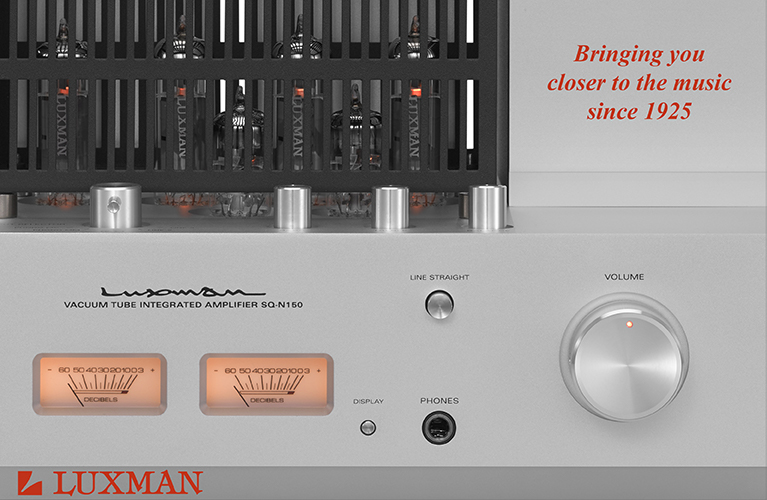These days I’m seeing so much great-sounding, great-looking, inexpensive audio gear, particularly from the UK, that I’m not sure there’s ever been a better time for the audiophile on a budget. In my August 2019 column, I wrote about two spectacular values from a British company founded in 1983: Audiolab’s 6000A integrated amplifier-DAC and 6000CDT CD transport, which respectively retail for $949.99 and $499.99 (all prices USD). This month I write about two high-value products from two other UK brands: Wharfedale’s Linton Heritage loudspeaker ($1199/pair, or $1498/pair with stands), and QED’s XT25 speaker cables ($84.99/2m pair).
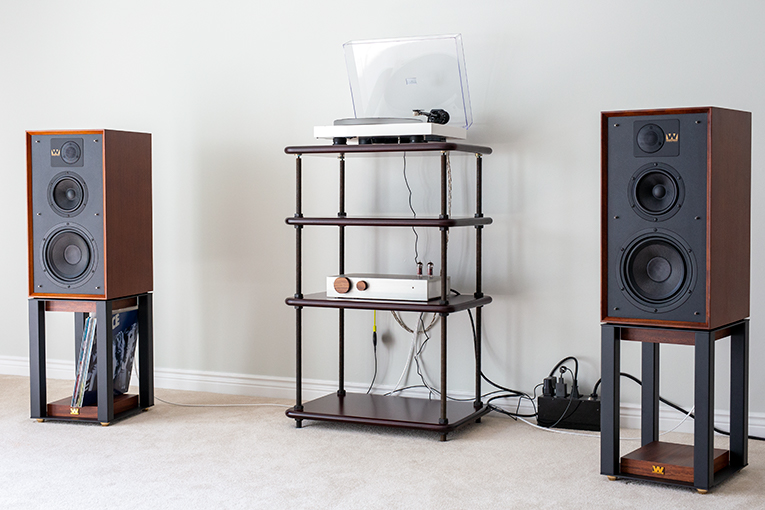
How do these brands create such high-value products? They have a few things in common, and one of them is where their stuff is made -- Audiolab and Wharfedale are both owned by the International Audio Group (IAG), headquartered in China, where their products are manufactured. QED is a sister company of Q Acoustics, makers of the 3020i and 3050i loudspeakers, which I wrote about in January. Q and QED are owned by Armour Home Electronics Ltd., based in the UK -- Q Acoustics speakers are made in China, QED cables are principally made in Taiwan. But the lower costs of Asian manufacture wouldn’t matter if the products from those factories didn’t sound good, which I believe has mostly to do with where all of these were designed -- the UK, where their R&D teams have always been based.
QED XT25 speaker cables
QED, established in 1973, is feeling confident these days. They claim that by using “‘top down’ design-principles,” they’ve put into their low-priced XT25 speaker cable everything they’ve learned in nearly half a century of cable design.
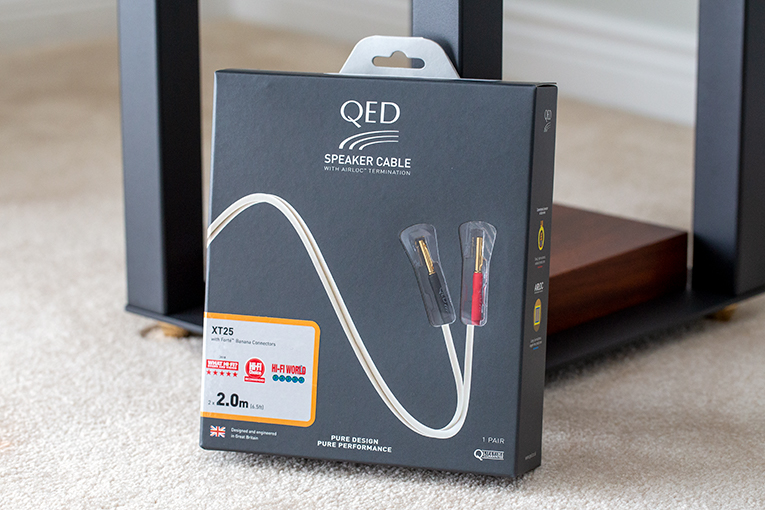
Each 14-gauge leg of the XT25 contains ten conductors, each conductor comprising 19 strands of 0.005”-diameter, 99.999%, oxygen-free copper. The ten conductors are wound around a single central X-Tube -- a hollow tube of thin-walled polyethylene. According to QED,
By forming the conductors into a tube-like shape with a hollow centre, current densities at higher frequencies are maintained because the electric field which contributes towards the skin effect acts towards the centre of the conductor from where the conductive material has been removed. At the same time instead of using a braided structure a ring of conductors is formed into separate bundles with only a loose electrical association which are then twisted into a 90mm lay so that no single conductor bundle remains on the inside or outside of the cable (and therefore prey to the proximity effect) for long enough for it to become an audible problem. This geometry promotes a more consistent signal distribution making for a more accurate musical reproduction.
This entire assembly is wrapped in aluminum-mylar tape, which itself is surrounded by a sheath of low-density polyethylene (LDPE). The positive and negative legs of each cable are joined lengthwise. The jacket is thick enough to protect the copper conductors within, and flexible enough to make it easy to snake the cable around and behind an equipment rack. Each end is terminated with one of QED’s Forte banana plugs -- a durable, gold-plated pin with a raised edge that runs much of its length and seems to make very solid contact with a binding post. Conductors and plug are joined using QED’s Airloc technology: “By using a cold weld crimp type termination Airloc plugs squash the conductors and plug together to improve contact area and reduce resistance.”
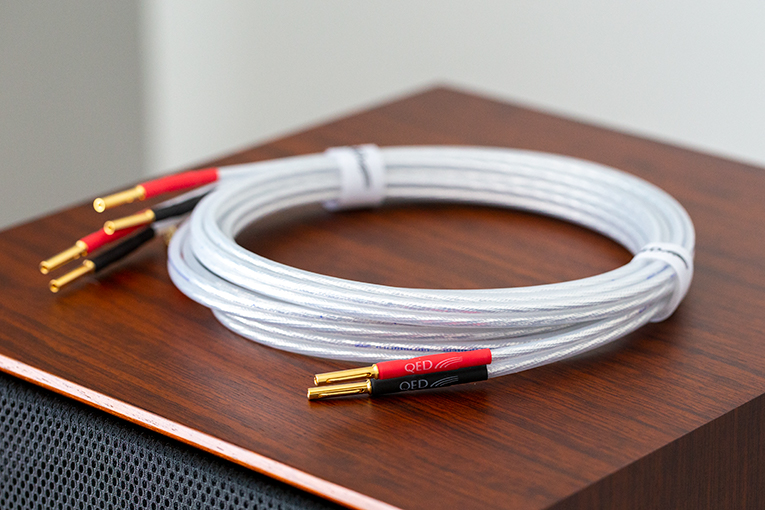
The XT25 is exceptionally well made for the price -- QED’s lifetime warranty covers all manufacturing defects -- and at 2m (the only length available), the pair of them were just long enough to join my power amp and speakers without too little or too much slack. The XT25s also look really good -- the shiny silver-white of the LDPE over aluminum-mylar has some pizzazz. Lest you think that cable appearance is unimportant, consider: Many people’s hi-fi systems occupy their living rooms, with cables run along the baseboard or even across the floor; it’s always better when cables don’t look like cheap lampcord.
I used two different systems for testing: Audiolab’s 6000A integrated amplifier-DAC with Wharfedale’s Linton Heritage speakers (see below); and Heaven 11’s Billie integrated-DAC (which I’ll write about next time) with Paradigm’s Monitor SE 3000F speakers (which I wrote about in July). I won’t wax poetic about the differences I heard when I replaced the speaker cables I used with both systems -- AudioQuest’s Q2 ($179/10’ pair, the shortest length available) -- with the QED XT25s, because I heard no differences at all.
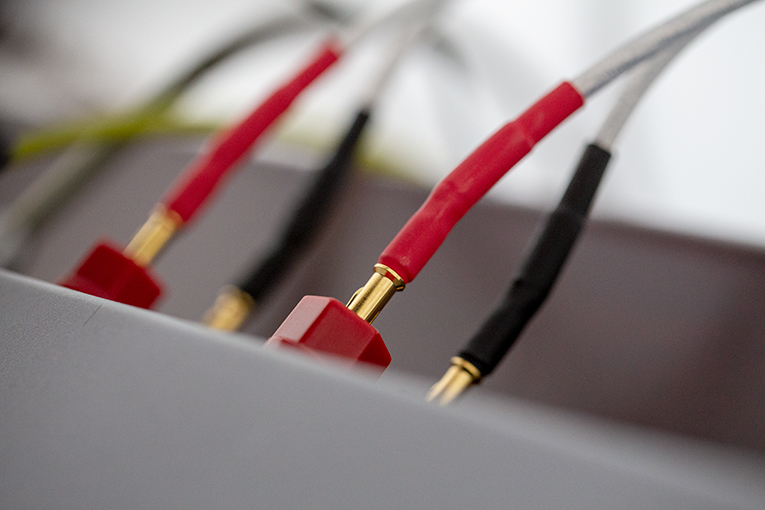
Because of that, and because I don’t need the extra length of the AudioQuest Q2s, which cost more than twice as much as the QEDs, the XT25s are staying in System One for the foreseeable future. Their build quality, sound quality, appearance, and warranty make them super-easy to recommend at $84.99/pair. Now I want to hear some of QED’s other cables . . .
Wharfedale Linton Heritage loudspeakers
The mantra of many hi-fi manufacturers these days seems to be Let’s make something old new again. That would explain why we see so many new components with retro visual designs. But, like any design choice, retro can be done well or poorly -- just because something’s appearance harks back four or five decades doesn’t guarantee that it looks good.
But if there’s one company that has earned the right to do this and has pulled it off, it’s Wharfedale. They’ve been making loudspeakers longer than most -- founded in 1932, Wharfedale is now 87 years old, and in that time has produced some pretty cool designs that they still draw inspiration from.
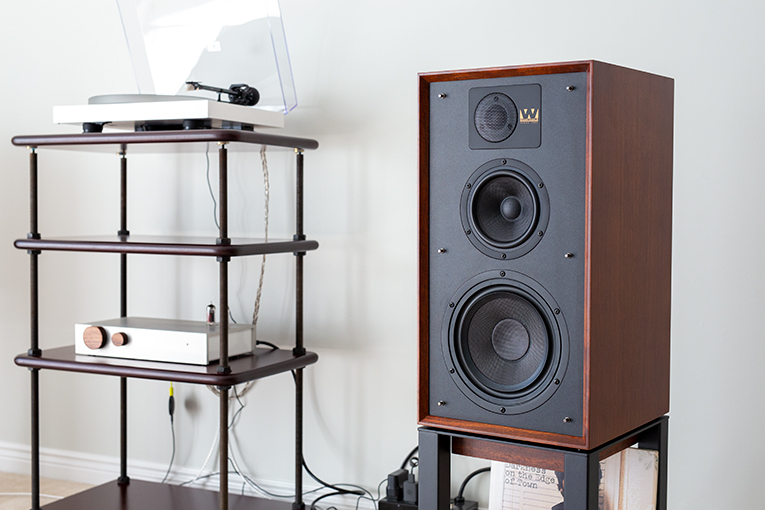
The new Linton Heritage is a re-creation of Wharfedale’s original Linton, launched in 1965. It’s part of Wharfedale’s Heritage Series, which includes the Denton 80 and Denton 85 minimonitors. The Linton Heritage lists for $1199/pair; add $299 for stands.
Like the original, the Linton Heritage has a big, boxy cabinet -- it measures 22.24”H x 11.8”W x 13”D and weighs 40.5 pounds. Except for the inset front baffle, the speaker is veneered in real wood on all surfaces -- even the rear panel. The baffle, painted matte black, is covered with a super-thick, old-school grille. Each cabinet wall is an MDF-chipboard sandwich, for an optimal combination of rigidity and damping. The speaker is a three-way: at top is a 1” soft-dome tweeter, below it a 5” midrange, and below that an 8” woofer, the latter two with cones of black woven Kevlar.
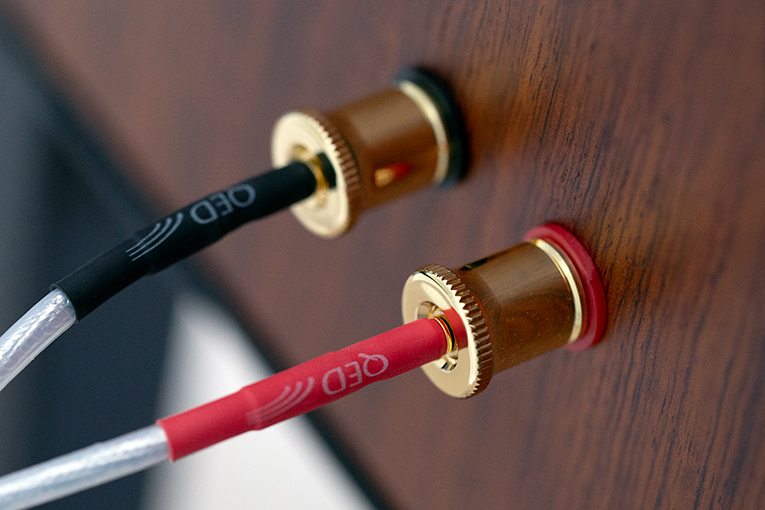
The Linton Heritage’s size, weight, sturdy build, and high-quality drivers make it hard to believe that it sells for only $1199/pair -- twice that seems more appropriate. A few things help explain the low price. First and most obvious, the Linton and its stand are made in China. I also noticed that the binding posts wobbled a bit, and the “nameplate” is just a sticker, not a plate of metal or even plastic. Finally, although the veneer is real wood, it doesn’t actually look much better than a good vinyl veneer. After I’d unboxed the Lintons, I contacted Wharfedale’s North American distributor, MoFi Distribution, to ask if the veneer really is wood. They assured me that it is.
Still, for its price, the Linton is wonderfully styled and built to a standard that, compared to most other speakers out there, exceeds its price. What makes the Linton even better is its optional stand, which I think should be considered mandatory, because its attractive look continues the visual design of the speaker itself, all the way down to the floor. Like the speaker, the stand is built to a higher standard than its $299/pair retail price indicates. Besides the attractive metal and wood veneer on the base and top, its four support columns are square metal tubes, each with a 2” x 2” cross section. The stand is welded together, which makes it solid and strong, and has four great-looking, good-size, triangular metal feet that screw into the base to give it an even firmer stance. Wharfedale has not cheaped out here, and the stand includes a nifty feature: The space between its top and bottom surfaces is tall and wide enough to accept a few dozen LPs.
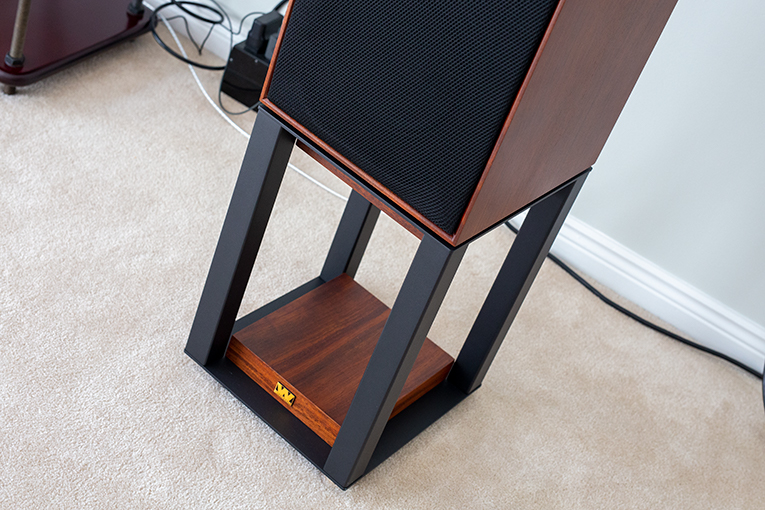
Before I describe the sound of the Linton Heritage, I want to talk about some of the acoustical challenges of speakers, like this one, shaped like models from the 1960s and ’70s, and why you don’t see many of them nowadays. First is their wide front baffles. Most speakers today have fairly narrow baffles, to reduce the amount of surface area that can reflect soundwaves produced by the drivers -- a kind of interference called diffraction. This is one of the things that helps modern speakers get out of their own way, to produce a more open and boxless sound.
On the other hand, a wide baffle can provide the benefit of higher sensitivity -- in other words, all else being equal, the speaker needs less power from an amplifier than does a speaker with a narrower baffle. This has to do with the baffle step, or the 4pi to 2pi transition. Basically, when the frequencies of soundwaves produced by the drivers have increased to the point that their wavelengths are shorter than the baffle’s width and/or height, the radiation of those soundwaves shifts from being mostly spherical (i.e., everywhere) to mostly forward. This shift in the shape of the radiation pattern is the baffle step -- when it kicks in, the speaker’s output at that frequency increases by 6dB, which is a lot. The narrower the baffle, the higher in frequency the baffle step occurs, and vice versa.
Designer Peter Comeau, acoustic director of all IAG brands, took advantage of the lower-than-usual baffle-step frequency of a wider-than-usual baffle to increase the Linton Heritage’s overall sensitivity. Wharfedale claims for the Linton Heritage a sensitivity of 90dB/2.83V/m, when modern, narrow-baffled speakers typically fall within a range of 86-88dB. Speaker sensitivity is important: Each increase in speaker output of 3dB requires a doubling of amplifier power; the higher a speaker’s sensitivity, the more easily it can be driven by low-powered amps.
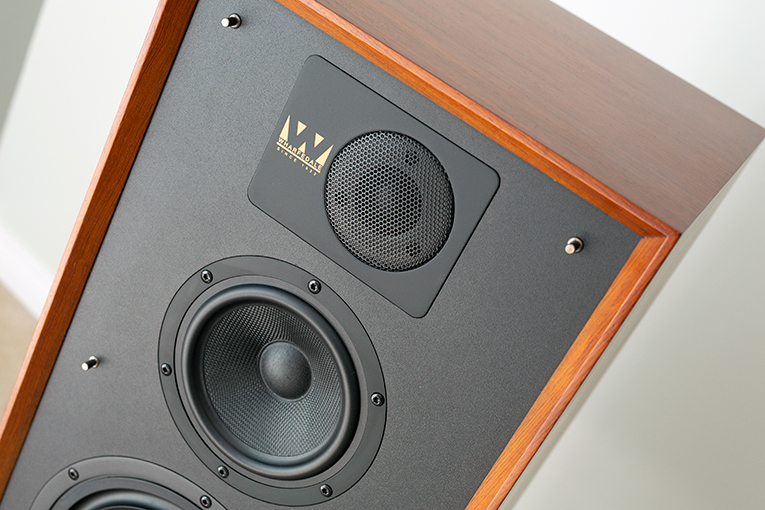
Then there’s the baffle. As far as I know, an inset baffle offers no benefit at all. It may look cool -- the Linton Heritage’s baffle is attractively framed by the cabinet’s edges -- but those edges create a nightmare of diffraction. Diffraction happens when a driver’s soundwaves, as they traverse the baffle, meet an obstruction such as a raised edge -- they bounce off these obstructions, to then interfere with the initial, undiffracted soundwaves now directly emerging from the driver. Depending on how the diffracted soundwaves interact with the direct wavelaunch, it can often cause a visible spike or dip in the frequency response.
To mitigate the diffraction caused by the edges of the Linton Heritage’s cabinet, Comeau did two things. With a laterally centered tweeter, the effects of diffraction are worse because the distance from the tweeter to each side edge is identical -- whichever frequency or frequencies are diffracted will be diffracted at both edges of the cabinet, thus doubling the total amount of interference at that frequency. But the Linton Heritage’s tweeter is offset to one side -- the two speakers of a set of Linton Heritages are thus not identical, but come in “handed” or mirror-imaged pairs. With the tweeter offset, because the distance to each edge is different, so are the frequencies affected -- rather than all occurring on the same frequency, the diffraction is split between two different frequencies, which will make any interference less audible. Typically, the Lintons will be positioned with their tweeters on the inside, as I used them -- but depending on the room’s acoustics, the other orientation might be preferable. Experimentation is in order.
Second, the Linton Heritage’s grille should be left on at all times -- Comeau designed it to help smooth the transition from tweeter to cabinet edges, which is why it’s so thick.
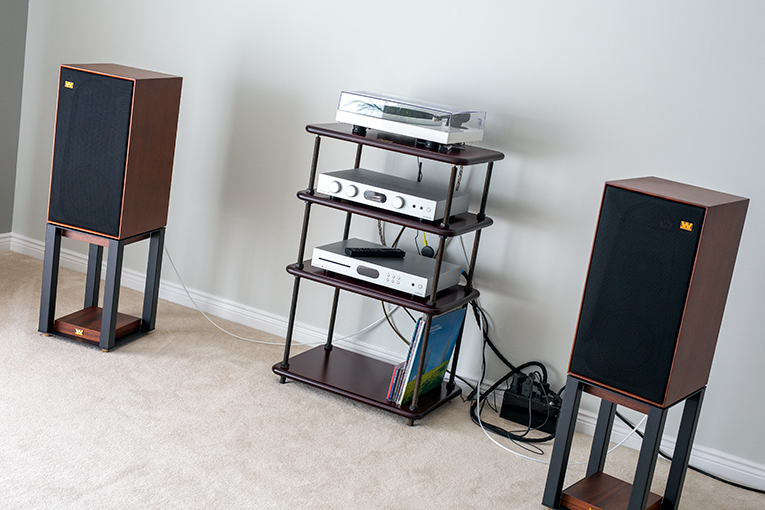
Despite the Linton Heritage’s old-school looks, there was nothing old-school about its sound -- no serious tonal colorations, no lack of detail, no diffuse midrange, no tizzy highs, no woolly bass. Driving the Wharfedales with the Audiolab 6000A or the Heaven 11 Billie integrated-DAC, and streaming music from Tidal through a Chromecast Audio dongle plugged into a TosLink input (both amps have TosLink jacks), the first thing I noticed was that the Linton Heritages sounded commendably neutral throughout the audioband -- no region within the range of human hearing sounded forward or recessed. The highs particularly intrigued me: nicely extended, very smooth, and truly refined, they were perhaps a bit polite, but never so polite as to sound dull. The bass was pretty deep -- it neared 30Hz -- and tight, with none of the blurry bass of decades past. There was also perfect cohesion from lows to highs -- I couldn’t tell where any driver handed off to another. Overall, I really liked what I heard from the Linton Heritages.
There was no better example of the kind of sound the Wharfedales produced than the title track of Blue Rodeo’s Diamond Mine (16-bit/44.1kHz FLAC, Atlantic). I was using the Heaven 11 Billie integrated to play this track for a friend, a drummer -- he marveled at how tight and punchy Cleave Anderson’s drums sounded, but he most liked how clearly the cymbals were reproduced. I noticed how natural and detailed Greg Keelor’s voice sounded in his lead vocal, and how much of the very reverberant recording venue I could hear as his voice echoed off the walls.
With both the 6000A and the Billie, I found I could play the Lintons really loud without strain -- much louder than I think anyone would need to ever play them. This speaks well for Wharfedale’s claim of high sensitivity -- at a respective 50 and 60Wpc into 8 ohms, the Audiolab and Heaven 11 are hardly the most powerful amps in the world. It also speaks well for Wharfedale’s “Peak SPL” spec of 110dB. They don’t specify the distance, frequency, or bandwidth at which they got that number, or if it’s for one or two speakers, but by stating it at all they’re clearly trying to say that the Linton Heritages will play LOUD. And they did.
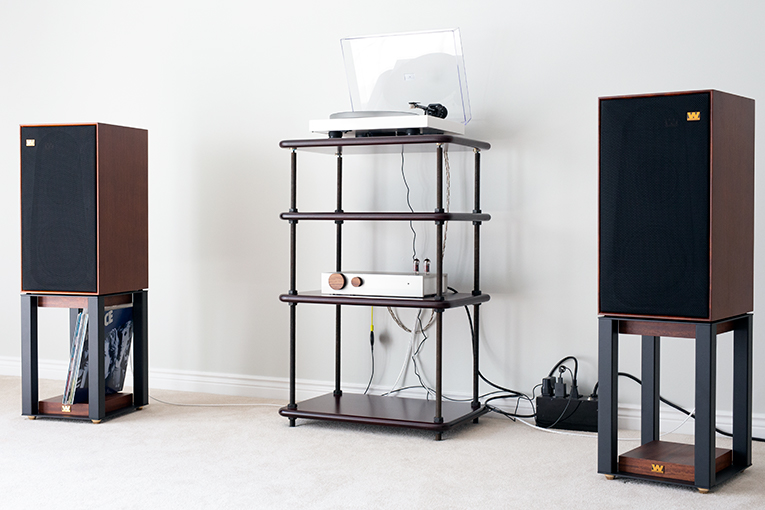
For example, with the 6000A in the system, I streamed “Go Your Own Way,” from Fleetwood Mac’s Rumours (16/44.1 FLAC, Warner Bros.), at volumes high enough that my ears began to ring. Needless to say, I didn’t want to listen long at that level, but I did want to know if the Wharfedales could cleanly reproduce Lindsey Buckingham’s searing guitar from 2:38 on -- I’ve heard that this passage can cause tweeters and midrange drivers noticeable distress at high volumes. The Linton Heritages reproduced it as loudly and cleanly as some of the best speakers at any price that I’ve reviewed
To similarly test the low end, I tortured the Wharfedales with the extremely bass-heavy “Bad Guy,” from Billie Eilish’s When We All Fall Asleep, Where Do We Go? (16/44.1 FLAC, Interscope/Tidal), at a higher SPL than I thought fair for them: wall-shakingly loud. For this test I used another Billie, Heaven 11’s, the slightly more powerful of the two integrated amps. I expected the Linton Heritages to badly distort -- as my car stereo does with this track, even when I play it at a “normal” volume. They didn’t. Instead, the Wharfedales cleanly hammered out prodigious bass, while keeping Eilish’s smooth voice as distinct and clean as it had sounded at lower volumes.
I was shocked that these speakers weathered both tests so well, especially the second. If you need to party with the Lintons, clearly, you can.
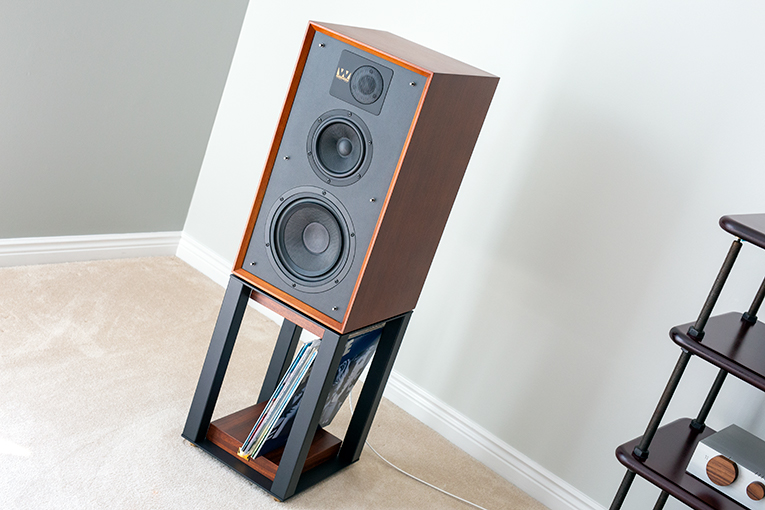
Based on the sound I was hearing -- neutral, clean, with no unreasonable constraints on dynamics -- I thought the Linton Heritage might be able to lay waste to any speaker even remotely close to its price. So, when I had some friends over, I pulled out Paradigm’s Monitor SE 3000F floorstanders to run some comparisons. Priced at $698/pair -- $501/pair less than the Wharfedales without the latter’s stands -- the four-driver, three-way 3000F isn’t a piece of eye-candy like the Linton Heritage, but in terms of sound quality it’s one of the highest-value floorstanders made today. It also looks and is designed like most modern floorstanders: fairly tall, with a narrow front baffle and a specified sensitivity of 88dB/2.83V/m.
I got a bit of a surprise. Regardless of which amp I used, the Monitor SE 3000Fs sounded not worse than the Lintons, but merely different, particularly at the frequency extremes; overall, their sound quality was just as good. The Paradigms’ bass output couldn’t flex the walls as could the Lintons’ -- as I mention in my July article, the SE 3000F’s low end goes off the cliff at about 50Hz -- and their highs were noticeably tipped up, which to some might sound a little bright. This meant that the Linton Heritages sounded a little more neutral throughout the audioband than the Paradigms, fuller in the low bass, and a bit more pleasant overall because of their more neutral highs. But the Paradigms sounded more detailed in the midrange, and a bit more transparent overall -- they projected the sound more openly, particularly voices, which sprang more freely into the room. This openness, combined with their slightly tipped-up highs, naturally made the 3000Fs sound slightly more spacious and more resolving of details. Finally, I don’t know which speaker would win an all-out loudness war, but a pair of 3000Fs could, like a pair of Lintons, play louder than anyone will likely need them to. (Still, if their sensitivity specifications are equally accurate, the Paradigm will need more power to do this than will the Wharfedale.)
My friends were torn, unable to decide which speakers they liked better. So was I -- I liked both of them, for different reasons.
But when it came to appearances, no one was ambivalent. My friends that day, like most people who visited while the Wharfedales were here, loved the Linton Heritage’s retro looks and generally high build quality -- and even non-audiophiles were surprised at the low price. When I told them that the Wharfedales listed for just $1498/pair, including those classy stands, they were invariably surprised. Usually, when I show a non-audiophile an audiophile speaker, it’s the reverse: they can’t believe any mere loudspeaker could cost so much.
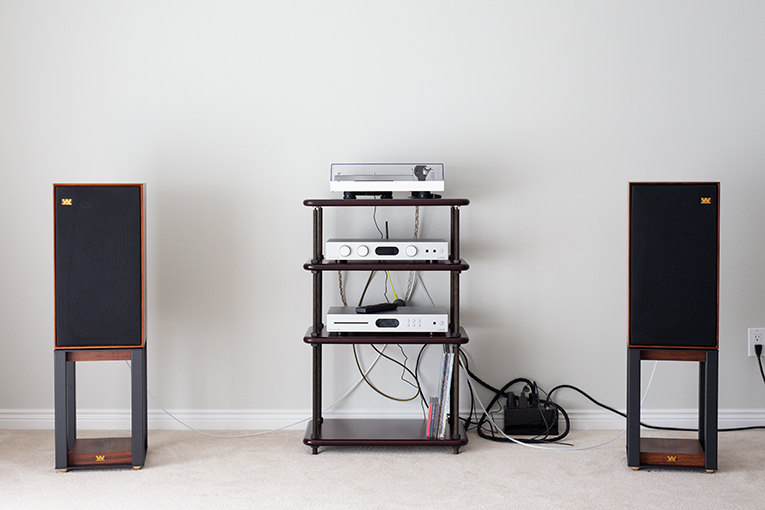
For those who want retro looks and good overall sound, the Linton Heritage with stands -- the only way you should buy them -- is a bargain. I know of nothing else anywhere near $1498/pair that combines its levels of visual styling, build quality, and sound. Even used vintage speakers can’t compete -- they might look similar, but I’d wager they won’t sound this accomplished, even assuming that their original drivers are still in good working order -- and I doubt their finish will be in a condition as good as a brand-new pair of Linton Heritages.
The Wharfedale Linton Heritage is a budget gem in a class of its own, at a price low enough that many can afford. Nice work, Wharfedale, in bringing to the masses a great-sounding speaker with a great retro look.
. . . Doug Schneider
das@soundstagenetwork.com






















